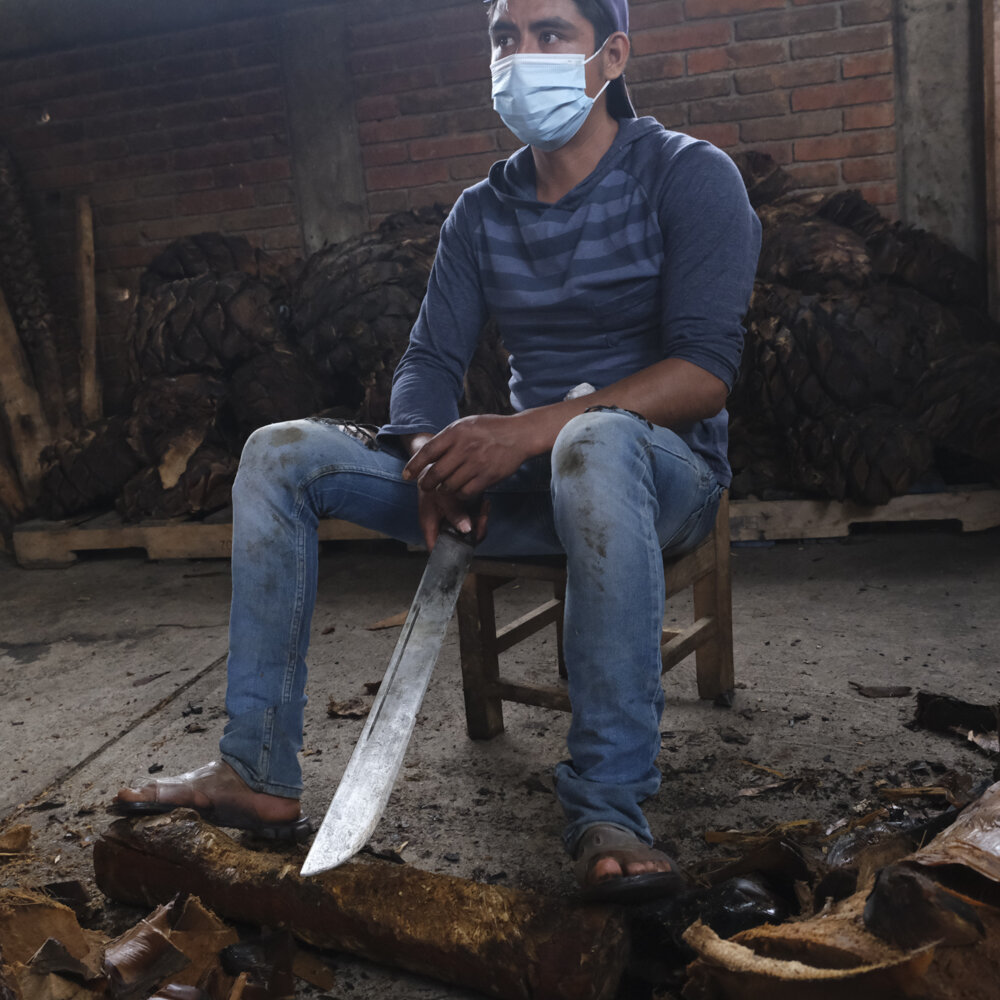Espadín con Quiote
50.64%, October 2020
Eduardo Ángeles, Santa Catarina Minas, Oax.
Some Basic definition of terms
There are two basic types of mature agave suitable for producing mezcal or agave spirits. The first is maguey velilla AKA en guía AKA cogollito, the terms used to describe agave that is fully mature and days or months away from sprouting its quiote (flowering stalk). The second is maguey capón or con quiote, the terms used to describe an agave that has sprouted its quiote, had the quiote cut by the magueyero, and been left in the field for some period of time before being harvested.
Some basic plant physiology
Agaves sprout new pencas (leaves) from the top of their piña (body,) known as the cogollo. The location of each new bud rotates around the center forming one or more complete circular rosettes per year, depending on the species, elevation and climatic conditions. As the plant approaches maturity in the months leading up to the the sprouting of its quiote, the new pencas will stop developing in spiral formation and become very thin. In the case of espadín, budding pencas will have a width of 20-30cm for most of the plant’s life, though they will become as thin as 10cm just before the arrival of its quiote. These thin, fixed-location pencas are the visual cue for magueyeros that the plant is velilla/cogollito/en guía.
Left untouched, the plant will draw its life savings of nutrients and water into the mezontle (heart of the piña from which the quiote grows) using them to grow the towering inflorescence, flowers, fruit and seeds for which the plant gives its life.
The magueyero might harvest the plant while cogollito, in which case we know what happens next.
The third possible fate for the plant is for the quiote to sprout, be cut by the magueyero and become capón (castrated). Unable to finish growing its quiote and bloom, the plant will eventually redirect its water and nutrients back into its extremities, a readjustment that can take between 4 and 12 months depending on varietal and its location. The back and forth of shifting water and nutrients brings about some important changes to the plant's physical and chemical composition. Where the piña of an espadín cogollito in Minas is something like 60% pulp and 40% fiber, a one-year espadín capón in Minas will be something like 30% pulp, 60% fiber and 10% wood. The piña of the espadín capón will also have something like 5-6% more sugar than a cogollito. Depending the varietal, environmental conditions, and exposure to insects and fungal pests, agaves can live for up to several years.
Some Magueyero Basics
If good mezcal or agave spirits is the goal, the plants used must not only be mature, but be in a period of stasis. This means magueyeros have two options:
Harvest the plant while cogollito.
“Castrate” the plant by cutting the quiote, then wait the 4-12 months for the plant to rebalance its water and nutrients, and itself “calm down."
If the plant is harvested in the in between stage - too soon after the quiote has been cut - the end result will be spirits that taste like they were made from immature agaves. As Lalo describes it, spirits produced from plants in this state of transition will produce flavors similar to unripe fruits.
If rushing the harvest of a maguey capón is a recipe for bad mezcal, letting them sit too long in the field will be a recipe for disaster. Castrated agaves, with their higher sugar levels, are both more attractive to pests, and less able to defend themselves. It’s expected that some portion of the piña from a maguey capón will be lost to insects, and that percentage goes up the longer the plant sits in the field. Beyond the threats to any individual plant, a colony of pests feasting on a capón agave will inevitably attack neighboring plants, creating a much larger problem.
This Batch
This is the first batch made from maguey con quiote AKA maguey capón that Lalo has made in two years. Because he doesn’t use any chemical pesticides, he takes extra care not to attract pests, and that includes limiting the amount of overripe maguey capón he allows in his fields.
While Lalo appreciates all well made batches produced from maguey capón regardless of varietal, he thinks espadín - relatively lacking in flavor and aromas - particularly benefits from the process.
In addition to his pest related concerns, Lalo has shied away from making capón batches because he feels the term has been co-opted by marketers and less scrupulous mezcaleros taking advantage of most consumers inability to distinguish between batches made from maguey cogollito VS capón, or dishonest claims about the length of time the plants were kept in the field after being castrated.
The espadines used in this batch were grown from seeds collected in 2005, cared for in a nursery until being planted in fields in 2007. Most were castrated in 2018, other in 2019, and were finally harvested in time to be distilled in October 2020.
Watch the Youtube video below to learn more straight from Lalo.









